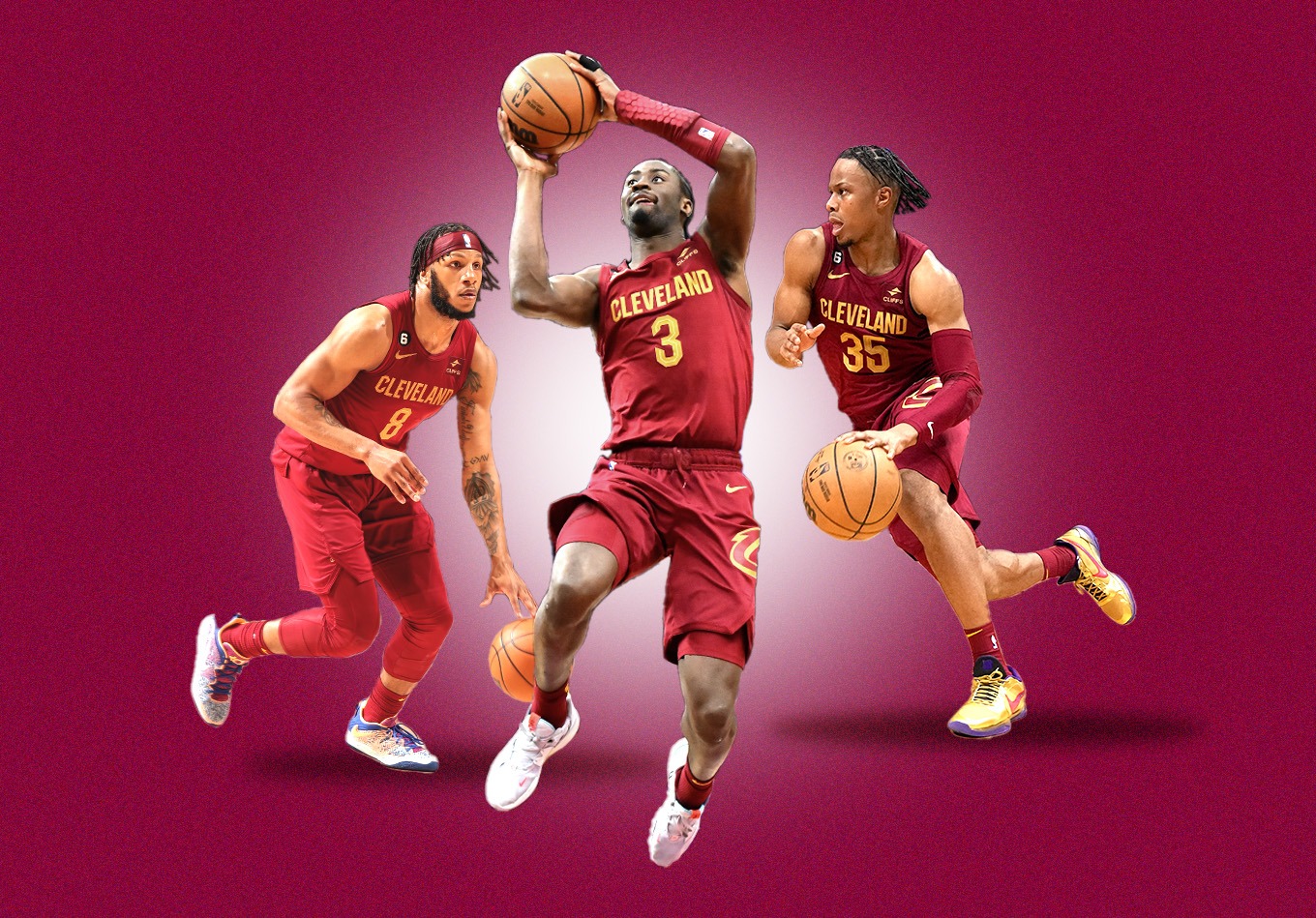When it comes to top fours, you’ll be hard-pressed to find a bunch better than the one rostered by the Cleveland Cavaliers.
Between Donovan Mitchell and Darius Garland’s synergistic offense (both rank in the top 25 in offensive DRIP, minimum 1,000 minutes played) and Jarrett Allen and Evan Mobley’s stifling defense (both in the top 15 in defensive DRIP), fewer teams tout the top-end balance touted by the Cavaliers fearsome foursome.
The problem here is that basketball is (typically) played with five players on the court. And unfortunately for Cleveland, the question of who that fifth player will be – particularly at the end of a close game in the postseason – has been a lingering concern all year.
So with the playoffs right around the corner, we decided to dig into the data to try and solve the curious case of who should be the Cavaliers’ fifth guy at the end of games.
What Should the Fifth Guy Be Able to Do?
While their top four is a pretty well-rounded quartet, the Cavs do have two glaring weaknesses: shooting and point-of-attack defense.
Allen is a complete non-shooter, and despite his best efforts, Mobley probably falls under the same designation – shooting 21.6% on 1.3 3-point attempts per game.
Meanwhile, due to their smaller statures and voluminous offensive responsibilities, Garland and Mitchell are best suited to play more of an off-ball role on defense. They really need a wing/forward who can shadow an opposing team’s primary perimeter option.
This hypothetical “3-and-D” fifth guy will also need to have the ability to drive closeouts. In the playoffs, game-to-game preparation increases drastically. As a result, opponents will try to mitigate the value of players they perceive to be spot-up shooters by running them off the 3-point line and forcing the shooter to beat them off the dribble (a maneuver known in basketball circles as the fly-by closeout).
Like Mobley does to sharpshooting big man Mike Muscala of the Boston Celtics below:
The theoretical fifth guy is going to need to be able to consistently counter this technique by, in some way or another, maintaining/extending the initial advantage created by his teammates.
Who Are the Ideal Candidates?
While veterans like Ricky Rubio and Robin Lopez could definitely receive some minutes in a playoff series against the right matchups, it is highly unlikely that the team will ever close games with one of those two players alongside the core four.
As for buyout acquisition and proven winner Danny Green, he’s only appeared in seven games since joining the Cavaliers and registered a DNP-CD (did not play – coach’s decision) in 12 of 14 contests before finishing with 21 points with five 3-pointers in Thursday’s blowout win over the Orlando Magic. So while there is a chance he might end up cracking the rotation, we are going to leave him out of this discussion for the time being.
That leaves us with five legitimate candidates: Caris LeVert, Isaac Okoro, Cedi Osman, Lamar Stevens and Dean Wade.
What Does the Data Tell Us?
To start, let’s compare these five guys’ (not to be confused with the delicious burger joint) outside shooting. Instead of the standard 3-point percentage, we are only going to look at their percentage on “open” and “wide-open” attempts because those are the types of looks they are usually going to get when playing alongside creators like Garland and Mitchell.
NBA.com defines “open” 3s as shots where the closest defender is 4-to-6 feet away from the shooter. In contrast, a “wide-open” 3 is one where the closest defender is more than 6 feet away from the shooter.
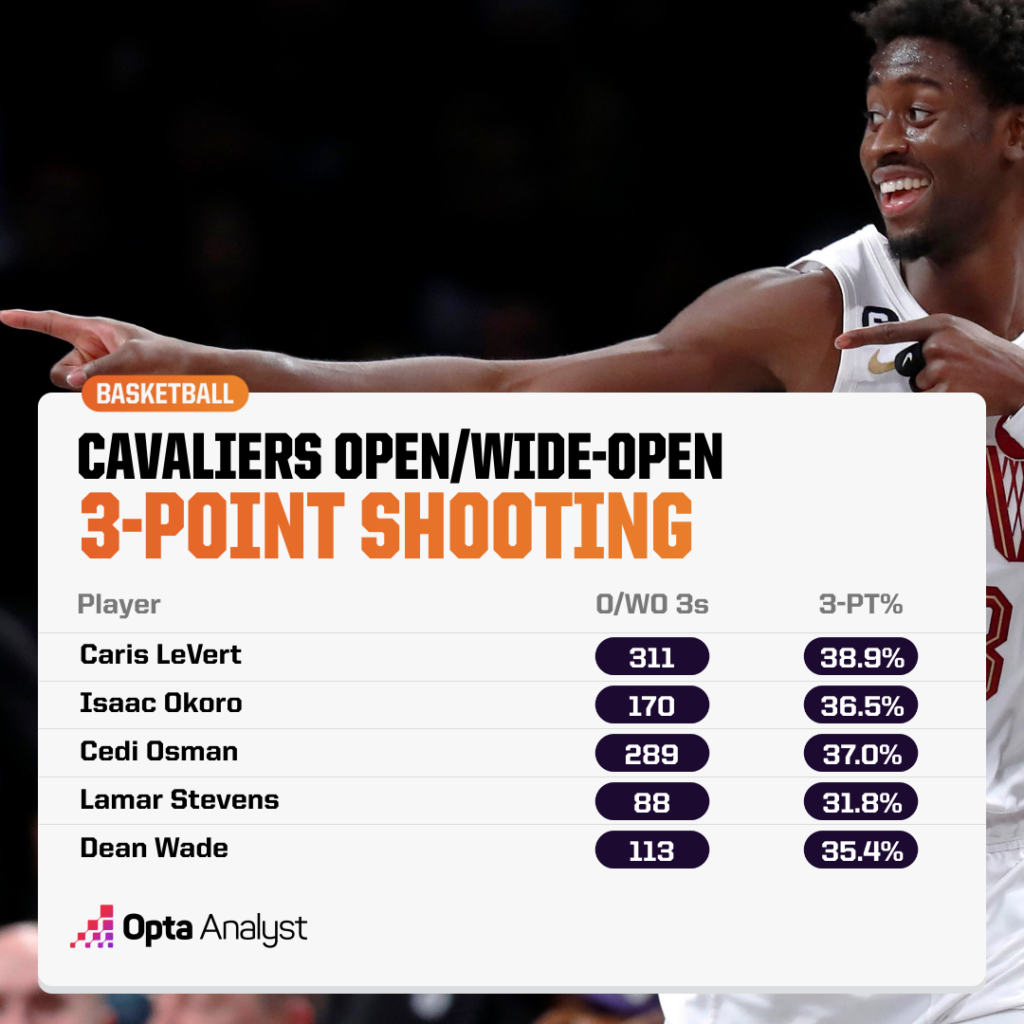
Outside of Stevens, it appears all of them can hit open/wide-open 3s at a respectable rate. But overall, LeVert seems like the best bet to do it at a good rate on high volume.
Next up, we mentioned the importance of not being neutralized when a defender tries to run you off the 3-point line. This can be accomplished in a myriad of ways. You can sidestep them and take a 3 from a different angle on the court (a Desmond Bane special). You can put the ball on the floor, drive to the rim and finish. You can drive to the rim and extend the advantage by passing it to the next teammate who becomes open.
Regardless of what method you choose, you likely will need to be able to take a dribble. To gauge each of these players’ aptitude for attacking in this manner, we will look at the frequency of their shots that come after one dribble or more.
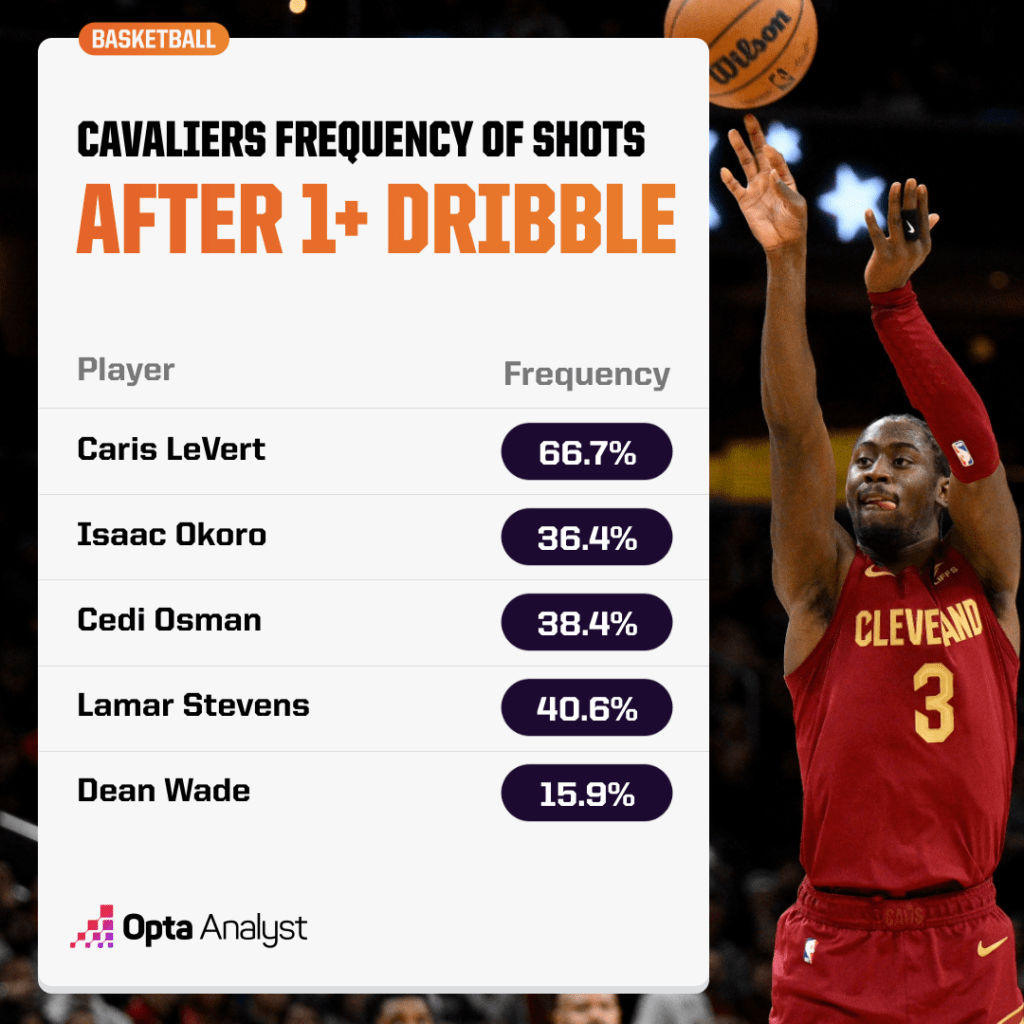
Once again, we have LeVert leading the group, followed by three guys in a similar range, and one player lagging behind (this time, it’s Wade trailing the pack instead of Stevens).
For on-ball defense, as is the case with most aspects on this side of the ball, it is incredibly difficult to find statistics that fully encapsulate how good one player is at this practice. However, between NBA tracking data and defensive DRIP (our catch-all metric, which projects a player’s defensive contribution to a team’s plus-minus per 100 possessions), we can get a solid estimate of where each player stands in this area.
The tracking data we included here is opponent efficiency on isolations and pick-and-rolls (as the ball handler) when being defended by one of these five. The reason we chose these two play types is that those are usually the kind of actions point-of-attack defenders will need to deal with.
We also included steal percentage (despite it being a better measure for off-ball defense) simply because it is a good proxy for overall spatial awareness and defensive positioning (important parts of being a good on-ball defender).
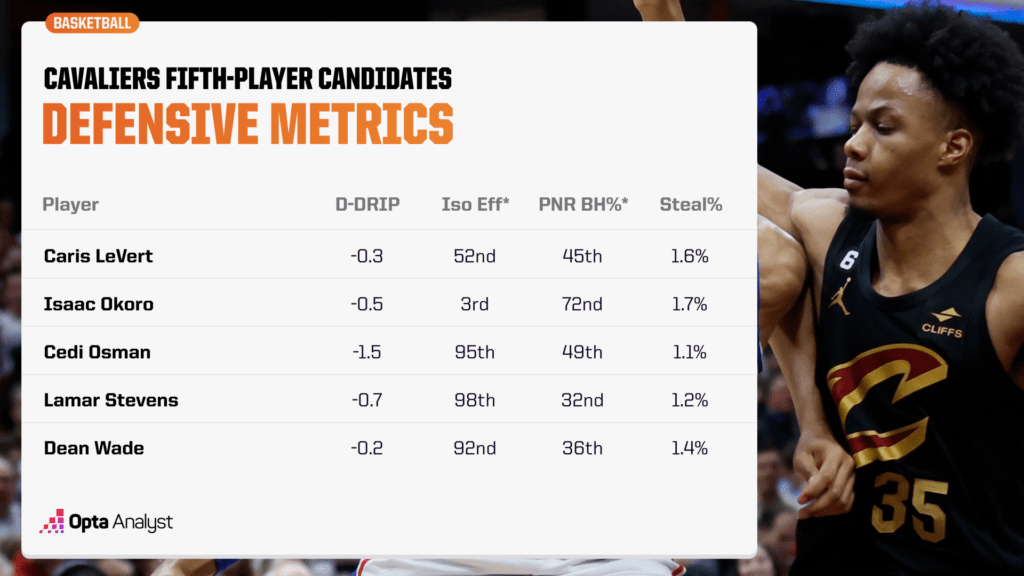
While LeVert led the way in the offensive statistics we highlighted, he’s only middle of the road in these defensive data points. What does this mean?
So Who Should Be Cleveland’s Fifth Guy?
The running joke about going to law school is that you copiously study the law for three years just to respond to people who have questions about it with the phrase: “it depends.”
And in this case, the answer is probably also “it depends.”
LeVert is clearly the best option to close games from an offensive standpoint, and at the very least, he can hold his own on defense. In what we consider “close games” (when his team is either leading by at most six points or trailing by at most six), he’s been given by far the most opportunities (see below).
So if the Cavaliers want to go with a more offensively-slanted lineup, they’re likely to go with LeVert.
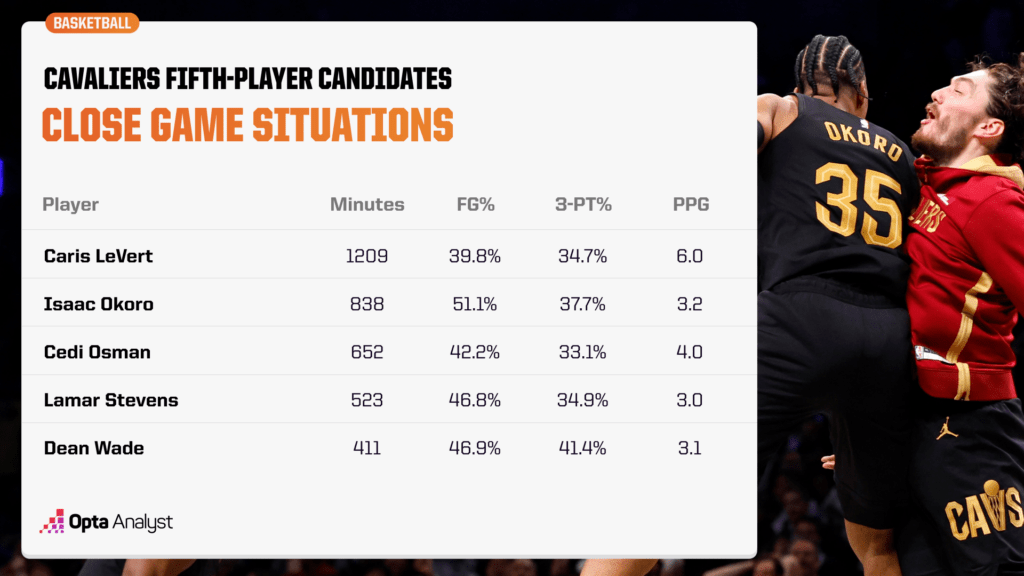
However, if Cleveland wants to go for a more defensive-centric approach (which it may need to do in its first-round matchup against the New York Knicks), Okoro should be the way to go. After all, on the year, he’s done a much better job than LeVert at defending the Knicks’ Jalen Brunson (and he maintains solid standing in the offensive data we referenced).
According to NBA.com, Brunson is shooting 2 for 11 from the floor (18.2%) on shots defended by Okoro, compared to 8 for 14 (57.1%) on shots defended by LeVert.
The important thing is that Cleveland has some depth and flexibility at that spot. And that should help make the Cavs a pretty dangerous team in the postseason.
